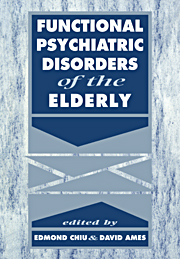Book contents
- Frontmatter
- Contents
- List of contributors
- Preface
- Introduction – A personal note
- Acknowledgement
- Part 1 Classification
- Part 2 General epidemiology
- Part 3 Neuroses
- Part 4 Affective disorders
- 7 The epidemiology of affective disorders in old age
- 8 The outcome of depressive illness in old age
- 9 Pseudodementia in geriatric depression
- 10 Depression in nursing and residential homes
- 11 Depression in primary care settings
- 12 Treatment of depression in the elderly
- 13 Mania in late life: conceptual and clinical issues
- 14 Suicide in the elderly
- Part 5 Psychosexual disorders
- Part 6 Substance use and abuse
- Part 7 Schizophrenia and related psychoses
- Part 8 Psychological, biological and medical issues
- Part 9 Treatment methods
- Part 10 Conclusion
- Index
7 - The epidemiology of affective disorders in old age
from Part 4 - Affective disorders
Published online by Cambridge University Press: 13 November 2009
- Frontmatter
- Contents
- List of contributors
- Preface
- Introduction – A personal note
- Acknowledgement
- Part 1 Classification
- Part 2 General epidemiology
- Part 3 Neuroses
- Part 4 Affective disorders
- 7 The epidemiology of affective disorders in old age
- 8 The outcome of depressive illness in old age
- 9 Pseudodementia in geriatric depression
- 10 Depression in nursing and residential homes
- 11 Depression in primary care settings
- 12 Treatment of depression in the elderly
- 13 Mania in late life: conceptual and clinical issues
- 14 Suicide in the elderly
- Part 5 Psychosexual disorders
- Part 6 Substance use and abuse
- Part 7 Schizophrenia and related psychoses
- Part 8 Psychological, biological and medical issues
- Part 9 Treatment methods
- Part 10 Conclusion
- Index
Summary
Introduction
Epidemiological studies can give information on the distribution of the various mood disorders (in time and place), and alert us to factors that appear to influence that distribution. Certain situations and changes may predispose individuals to develop depression or elevation of mood, precipitate it, prolong its course or alleviate it. Such knowledge may allow us to take a preventative approach, or may help in planning our clinical interventions.
Awareness of the prevalence and incidence of mood disorders is important when planning health services, but we need also to know how effective our various health services are. What do the outcome studies show? Of those who might benefit from our interventions, what proportion are referred to appropriate services?
In this chapter, attention will be given to the prevalence of depressive and bipolar disorders among elderly people in the community and in institutional settings. The importance of physical disorders in relation to depression in old age will be stressed, with particular mention of Parkinson's Disease, cerebrovascular disorders and organic brain disease.
More detailed discussion of depression in residential and primary care settings will be found in Chapters 10 and 11. The relationship between rates of suicide and depression will be reviewed in Chapter 14.
Perhaps the most important question to ask (before attempting to identify depressive disorders in the community, hospital or elsewhere) is this: if we find it, what can we do about it? Is it worth knowing? As will be shown, the prevalence of depressive symptoms and syndromes in old age is high, especially among the physically ill.
- Type
- Chapter
- Information
- Functional Psychiatric Disorders of the Elderly , pp. 95 - 110Publisher: Cambridge University PressPrint publication year: 1994
- 5
- Cited by



